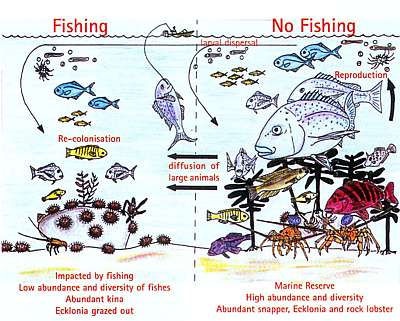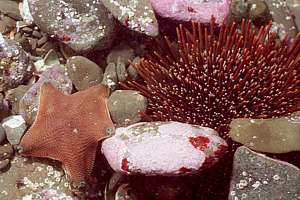|
marine reserves do not cause habitat changes by Dr Floor Anthoni (2009) www.seafriends.org.nz/indepth/snapper-urchin.htm |
 |
 |
|
marine reserves do not cause habitat changes by Dr Floor Anthoni (2009) www.seafriends.org.nz/indepth/snapper-urchin.htm |
 |
 |
|
|
Scientists noticed how inside the Goat Island marine reserve, urchin
barrens disappeared as the kelp forest took their place. They reasoned
that this was caused by the large snapper and crayfish who eat the sea
urchins, who otherwise would have eaten the kelp. Fewer urchins means more
kelp. Thus big snapper leads to more kelp. Urchins bad, kelp good. Marine
reserve good.
However, the scientists were dishonest and ignored previous experiments and later experiments that disproved this hypothesis. Seafriends has extensively debunked the research done in a separate, large chapter, but here we'll present the important arguments so that everyone can understand the issue. |
.
| What did scientists notice?
Scientists noticed how urchin barrens disappeared from the Goat Island marine reserve, around 1998, twenty years after the reserve was established. They reasoned that large snapper had been eating sea urchins that normally attack kelp, because inside the marine reserve the snapper were allowed to grow more numerous and bigger, and so did crayfish. Their conclusion: marine reserves can have late effects on their environment, a so-called trophic cascade. Although entirely reasonable, this is entirely false. Regrettably, this myth has spread far through the scientific literature and is now taught at NZ schools! A major scientific scandal! So what is the real story? |
| What did scientist do?
Scientists observed that the barren urchin habitat at Goat Island and nearby Tawharanui( marked in red) was invaded by the kelp, and they reasoned that this was caused by marine protection. However, when they looked at all other east coast reserves (Mayor I, Hahei, Poor Knights, Long Bay), this was not the case. They then compared Goat Island and Tawharanui with the area outside, and obtained questionable just positive results. However, had they looked at nearby Kawau and Little Barrier Island (marked yellow), they would have seen that there too, the urchin zone had disappeared (in 2007 this extended over most of the east coast). Scientists had conveniently hushed up that in 1993 the whole kelp forest disappeared and in 1994-98 the sea urchins died by eating poisonous plankton slime. We observed that the urchin zone disappeared only where the kelp forest had disappeared in 1993. |
 |
 |
Since about 1985 there have been sporadic outbreaks of a poisonous slime,
identified as an Ostreopsis benthic dinoflagellate species. Although
it does not attach firmly to the substrate, it is nonetheless rather sticky
and not easily removed by waves. After the kelpbed death, the sea urchins
were no longer 'penned in' their barren habitat zone and wandered off into
the deep. As a result, the insufficiently grazed barrens were first infected
by this poisonous slime that killed a large percentage of sea urchins.
The barren area was now so poorly grazed that the kelp could survive where
it previously couldn't, and it invaded the urchin barrens. From an ecological
standpoint, this was possible only because the kelp plants were all of
same age. We have arial photos (see below) that show that the main invasion
happened in 1999, and not as scientists say, gradually from the very beginning
of the marine reserve.
It must also be noted that we discovered that the urchin barrens are
in fact storm barrens, created by large storms such as tropical cyclones.
It must also be noted that we haven't had many such storms in recent times,
and Cyclone Oli of 1993 is the last one. It can be expected that the next
Tropical Cyclone (hurricane) will clear the storm barrens again. In the
meantime, much smaller storms cause huge wash-ups of broken kelp.
 |
 |
 |
 |
 What
do our children learn? What
do our children learn?
Outside marine reserves, one finds barren areas dotted with sea urchins. These attack the kelp, thereby creating a barren zone and reducing biodiversity. The fish here stay small because they are caught. Inside marine reserves, however, the snapper and crayfish grow large enough to eat the sea urchins (kina) and this allows the kelp to return, feeding the weed eating fish, while also increasing biodiversity. As fish become more numerous and large, their spawn increases substantially. Currents move their eggs to the areas outside, replenishing fish stocks. Kelp GOOD, urchins BAD. |
| But what is the reality?
Snapper and crayfish do not have a preference for sea urchins, as has been shown by several studies. Urchins died from poisonous slime. After the kelp forest died, urchins spread out. The new generation of kelp was all of same age, swamping all areas. Large predators eat other animals, and the total spawn mass decreases (sea urchins are copious spawners). The barren habitat is home to large populations of other grazers like snails, limpets, chitons and fishes like triplefins. It is a very productive area because the sunlight reflects from the light-coloured calcareous algae (pink paint). It is also the spawning habitat of many plankton feeders like demoiselles, triplefins and black angelfish. Worst of all, when seaweeds are not eaten, they rot, infecting other species. In March 2009 most life disappeared from the famous Echinoderm Flats. In 2007 we established that the urchin barren zone disappeared from North Cape to East Cape, and also on outlying islands. In all cases there was an infestation of Ostreopsis. |
 |
 |
 |
| Why is Ostreopsis such a problem?
We don't know for sure, but Ostreopsis may just be one of the symptoms caused by overnourishment of the sea. An excess of nutrients from the land fertilises the plankton and encourages the growth of bacteria and noxious microbes such as Ostreopsis. Over the past 20 years we have observed and documented the rapid decline of nearly all marine species, either directly from disease or indirectly from lack of food. Seafriends was established precisely because we saw this happening as early as 1987! There exists a new threat in the sea that is growing rapidly and is already larger than the threat from fishing. |
| What went wrong?
How was it possible that scientists made such a big mistake?
|
| One would have thought that the first marine reserve
in New Zealand would have been monitored extensively, thoroughly and continuously,
but this is not so. In the beginning years there was enthusiasm for counting
the fishes, in the hope that they might become numerous. The graph shows
that this was not the case. It must be remembered that whenever a fished
area is closed, the fish stocks immediately begin to increase, as was inded
the case with crayfish, shown below.
The graph shows how snapper first increased as expected, but then declined again. The only real winner here is the red moki, a fish that finds all it needs inside the marine reserve where it is attracted to a sleeping hole. It doesn't migrate out for feeding or for spawning, as most snappers do. Scientists can show that the reserve contains more big snapper than outside, but most of this is caused by displaced fishing to the area outside. In any case, the disappearance of sea urchins cannot be explained from the population of snappers. |
 |
| The crayfish population inside the Goat Island marine
reserve can be called a success story, again because crayfish do not migrate
a lot and they find all they need inside the marine reserve: food, mates
and a sleeping hole.
The graph shows that crayfish populations immediately began to increase and then hovered around amximum of 30 bugs per 500 square metres. However, in 1998 we observed the sudden collapse of the population, as documented in monitoring the Goat Island marine reserve. In 2000 scientists discovered that 5 out of 6 crayfish had disappeared. Since then the population is slowly recovering, although not very visibly for divers. The populations outside the marine reserve remain much smaller because of displaced fishing effort, poorer habitat and too aggressive fisheries management. |
 |

Related chapters on the Seafriends
web site:
Storm
barrens of northern New Zealand: an overview of storm barrens, with
and without sea urchins. Many photographs.
Science
exposed: Exposing fallacies in ecological marine research in northern
New Zealand (urchin barrens rebuttal)
Introduction
to habitats: what makes life underwater so different?
Biodiversity:
what is biodiversity and how does it apply to the underwater environment?
Marine
conservation: understanding marine protection and how it is overvalued.
Frequently
asked questions about marine reserves: your no-nonsense introduction
to the myths around marine reserves.
Goat
Island: the Goat Island marine reserve. Does monitoring
show high abundance and diversity?
Poor
Knights: the Poor Knights Islands marine reserve. Does it protect
biodiversity?
References
For corrections and suggestions, e-mail
the author.
[in-depth index] [home][top]